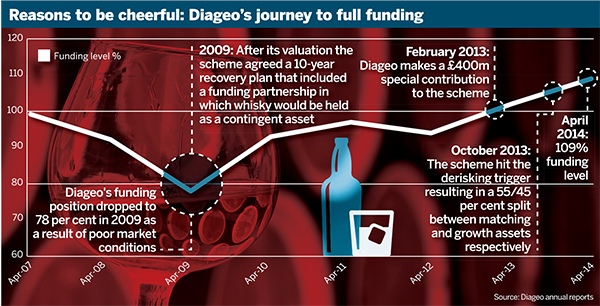Diageo Pension Scheme has switched 5 per cent of its assets from its growth to its matching portfolio after hitting a derisking trigger, tipping its investment balance towards holdings that track liabilities.
The drinks group’s £5.7bn scheme terminated a UK equity mandate to invest in lower risk assets including new mandates in private senior secured commercial loans, private senior secured property loans and directly held property, according to its 2014 scheme review.
The general trend over derisking continues... it’s more question of how and when these triggers are put into practice
Peter Martin, JLT Employee Benefits
The scheme hit the trigger in October 2013, resulting in a 55/45 per cent split between matching and growth assets respectively, from the previous 50/50 split.
The investment strategy aims for “long-term performance without taking unnecessary risk”, the review stated.
It added: “This is done by switching out of higher return-seeking growth assets, such as equities and property, which are higher risk, into matching assets, such as bonds, with a risk and return profile more closely matched with the liabilities of the scheme.”
Its funding level increased to 109 per cent at April 1 this year, up from 102 per cent in 2013 and from a low of 78 per cent in 2009.
In February last year the company made a special contribution of £400m to the scheme, following an enhanced funding deal in 2009.

The scheme also increased its interest rate hedge to 40 per cent of its liabilities shortly before March of this year, up from 30 per cent the same time the previous year.
The review stated the trustees are aiming for the scheme to be fully funded on a solvency basis and invested in lower-risk assets, which are designed to move broadly in line with its liabilities.
“Since lower-risk assets normally deliver lower investment returns, the scheme will need to improve its funding position to achieve this,” the review said.
The scheme previously reduced its exposure to equity-based hedge funds and increased allocation to other hedge fund strategies as it sought increased diversification in its portfolio.
Balancing growth and risk
Peter Martin, head of manager research at JLT Employee Benefits, said there is more talk within the industry about using hedging triggers based on forward rates, due to current low yields.
“The general trend over derisking continues,” said Martin. “It’s more a question of how and when these triggers are put into practice.”
Kevin Frisby, partner at consultancy LCP, said he has seen “an uptick in more specialised fixed income products”, such as senior secured loans, despite the fact they may require trustees to spend time getting up to speed with them. But he added credit is looking expensive at the moment as spreads have compressed.
Frisby suggested schemes looking to match their liabilities could invest in a liability-driven investment fund and absolute return bond funds to generate return, as well as a cash holding giving access to collateral quickly.
“If you are at the end of the spectrum where you are fairly well funded but you have also [LDI] funds because they are more efficient, you still need to generate some return,” he said.
Diageo declined to comment on its fund’s investment strategy.














